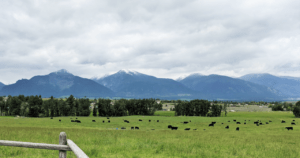
After working with their neighbors and the Bitterroot Land Trust for a couple of years, Jake and Fannie Yoder were able to realize a deal that would not only ensure that their place remains a working ranch in perpituity, but also double it in size. The deal that made it possible was a conservation easement developed by the Bitter Root Land Trust and funded in part by money from the county’s Open Lands Bond Program. Of course, it meant passing up some multi-million-dollar deals for some other type of development along the way, but that would have meant giving up what matters most according to Yoder, the place where he and his family have come to live.
Jake and Fannie and kids moved down from St. Ignatius six years ago and bought half of an old ranch, about 70 acres, that was divided and sold in two pieces about 30 or 40 years ago. They came to love the place. Yoder is mostly known for his gravel pit operation along the Eastside Highway just north of Stevensville. But he and his wife and family have also managed the Yoder Angus Ranch for the last six years.
The ranch sits atop Illinois Bench on Stevensville Airport Road. They currently run 80 Black Angus cows on the property. The land is irrigated by gravity-fed wheel lines with water rights from the Bitterroot Irrigation District coming from the Big Ditch.
Yoder said that it was Kyle Barber of the Bitter Root Land Trust who first talked to him about the potential of placing a conservation easement on his place. He said the way it was laid out, it would allow him to purchase the adjoining 80 acres from his neighbor, reuniting the old ranch under a 150-acre conservation easement.
The property under easement contains two residential sites: one existing site in the southeast portion of the property which also contains agricultural structures with a building envelope encompassing 2.5 acres. The second is an undeveloped site on the southwest corner of the easement property reserved for new residential development with a building envelope encompassing 1 acre. Along with the two residential sites, an agricultural building envelope around the existing ag structures on the property’s eastern boundary will encompass 1.25 acres.
All building envelope sites will be included within the conservation easement. In the future, the ranch must transfer as a single 150-acre tract. No splits will be permitted. The total acreage of the building envelopes is approximately 4.75 acres and the application states land reserved for undeveloped future home sites will be less than 1% (1 acre reserved or 0.7% of the property) of the total conservation easement acreage.
A recently awarded grant for $150,000 from Ravalli County’s Open Lands Bond Program made the deal possible. The 155-acre easement is valued at $390,000, but with an additional $35,910 in anticipated cost, the total budget for the easement was $425,910. The project also received $195,000 in funding from the NRCS Agricultural Land Easement Program. The landowners donated $80,910 of the donated easement value and retained $309,090. The proceeds helped offset the cost of the additional property.
According to the Planning Board’s staff report, the property’s values proposed for conservation include working agricultural lands, which includes controlled, no-till rotational grazing efforts which provides an abundance of habitat resources for livestock and wildlife, wildlife habitat including agricultural grasslands and riparian corridor habitats providing direct benefits for locally important species and communities of concern. The property is also encompassed within an Elk Winter Range of the Rock Creek Management Unit, Big Game Habitat Priority Area in relation to Secretarial Order 3362, and within a Tier 1 Terrestrial Focal Area of the State Wildlife Action Plan of the Lolo-Clark Fork Connectivity Focal Area. It preserves scenic open space including scenic road frontage along Stevensville Airport Road, Big Horn Lane, and Sage Creek Road while confining future residential use to the existing locations within its development envelope, therefore ensuring aesthetic views to be on display in perpetuity.
“To me it’s just using a bit of common sense that the good Lord gave us and thinking about life a little bit instead of just making an easy buck and then moving on,” said Yoder.
“I do construction and I know things have to develop” said Yoder, “but I am against the thought of breaking a hayfield up for houses. To me that’s not right. I know it’s easy money these days, but the day’s coming when we will wish for open areas and when those houses are on there, it’s over, it’s done, and it will never come back.”
“One thing my dad always said was, ‘when the group is running you had better be walking. And when they are walking, then you need to be running.’ The idea was to not just go with the flow of what’s happening, because you need to be thinking about what’s happening. That was his statement many times and I remember it quite well.”
“I had guys ask me about developing my ranch. Prices are skyrocketing right now. But when I think of my kids, I could not do that,” said Yoder. “I think in the long term the easy money is to develop it, but that’s going to change some day. Someday the wide open spaces and the open ranchland is going to be worth a lot of more.”
Yoder said in the meantime, “80 head of Black Angus cows sure looks a lot better than 50 houses.”